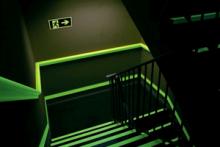Escape route illumination- the history
Escape route illumination - the history
Photoluminescent, Phosphorescent, materials that are excited by ordinary light waves and then in darkness release the energy into a potential life-saving illumination. Too good to be true?
An immediate light source in darkness, power failure delivered from ordinary ambient illumination – Free energy – The Holy Grail – Free energy and no maintenance – a no brainer for property managers that spend £1000’s on back illuminated sign boxes. Why?
The technology has been around for over 50 years but played a massive contribution to life saving in the atrocity of 9/11. Photoluminescent stairway illumination is now required in all commercial tall buildings in New York City.
Over the 50 year history the requirement for photoluminescent safety wayguidance systems has been introduced as a consequence of tragedy. On board aircraft after a tour jet caught fire while taking off at Manchester Airport. The familiar tram lines of illumination highlighted by your stewardess to indicate your safety route path. On board every passenger ship, ferry or vessel as a consequence of the Scandinavian Star and the Herald of Free Enterprise being plunged into total darkness by fire or capsize. On your train journey the familiar trim illumination on the baggage rail as a consequence of train crash derailment, fire, loss of power for passenger orientation and escape identification.
Slowly but surely photoluminescent safety wayguidance systems make their way almost unnoticed, unrecognised and passively waiting, should a sudden power loss emergency occur. Even 7.5kms of UK road tunnel fitted with continuous photoluminescent coated stainless steel profile. As a consequence of systems being installed building managers, fire safety managers, and organisation stake holders including insurance underwriters approved inspectors and enforcement authorities require documentary proof that photoluminescent material used for life safety meet recognised performance criteria.
Over the last 30 years, testing, accreditation and research program provenance now underpin the massive improvements in the refinement of phosphorescent rare earth and product development. Products that include flexible vinyl, rigid pvc, coating, coated stainless steel and aluminium plus 1000’s of individual products that locate life safety equipment from AED device, fire extinguishers, emergency breathing equipment, escape routes and evacuation devices. All illuminated in sudden darkness or should smoke obscure the normal lighting.
Luminance characteristics are critical to the effective performance. Photoluminescent materials must excite at low illumination, only 25 lux of fluorescent is the test for passenger ships and vessels. 50 lux of fluorescent for trains. Conformance to BS ISO 17398 luminance characteristics is essential with confirmation given in BS ISO 16069 for safety wayguidance components with classification as an absolute minimum in the UK for location safety signing and the profligate “fire exit” sign.
There will be further developments in the pipeline as a consequence of further identified risk areas and recent incidents. In the UK notice has to be taken of a Coroners Rule 43 that noted identification, location and orientation problems that fire and rescue services had within social housing purpose built flats.
Plus the further application in stairway management for tall buildings, commercial shopping mall and university halls of residence, not forgetting the unfamiliar staircase in hotels.
The case for photominescent systems is so strong, simple, permanent, low maintenance, no energy and effective. Life safety illumination without testing burden. It is checked by turning the lights off – how simple is that!
These systems are now being supplied to compliment, and in risk assessed cases as an alternative to traditional hard wired emergency lighting.
Why not ask your provider?
Published 28/02/2017


